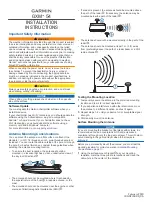
5. The reflector bracket rotates through 90˚. When boxed it is usually in the
horizontal position as it takes up less space. Before attaching the reflectors
the bracket must be rotated into the vertical position as shown in Fig. 6.
If you need to rotate the bracket push it towards the front of the aerial to
unlock, then rotate clockwise through 90˚ using the arrow as a guide then
pull the bracket back into it’s original position. *
6. Slide the reflectors into the reflector bracket until the locating studs click
into place as shown in Fig. 6.*
7. Use the tilting mast clamp supplied to fix the aerial securely to the mast.
Adjust the tilt angle to make sure the aerial is horizontal, see Fig. 7 and 8.
8. Connect the aerial downlead to the ‘F’ socket on the aerial balun
(be careful not to over tighten the F connector as this will damage
the balun). Ensure that the weather boot is correctly secured over the
‘F’ connector and socket - see Fig. 9.
Make sure that the coax cable is routed as shown in Fig. 9 (through the
middle of the lower reflector).
Use insulating tape, to secure the the coax downlead
to the reflector and mast.
8. Fine adjust the tilt and direction of the mast clamp to tune for
optimum reception.
*Please note that when the reflector locating studs have clicked into place the reflector
bracket is locked into position. If you are unable to push the reflectors in completely to locate
the studs make sure the bracket has been pulled right back.
Troubleshooting
No picture:
Check all connections from aerial to TV.
Poor picture:
Check all connections
from aerial to TV. Check aerial is properly aligned to the correct transmitter.
If the aerial has been loft mounted try mounting outside. Make sure new
digital coax cable has been used throughout the installation.
Check the transmitter signal is not obstructed by nearby trees or buildings.
If in a very weak signal area or for long cable runs,
installing a masthead amplifier will improve the signal.
If in a strong signal area the signal strength may need to be reduced by
fitting an attenuator.
Caution
When mounting the assembled aerial, always observe safety precau-
tions and use the correct equipment.
Unless you are competent in the use of ladders and other
access equipment,do not work outdoors at roof height.
If in any doubt, refer to a qualified aerial installer.
© Philex Electronic Ltd. 2013. v1
Fig. 7
Insulating
Tape
Fig. 9
F Connection
Reflector
Weather Boot
Useful Websites for Digital Advice:
*To find out which DTT channels should be available locally and
to find out where your nearest transmitter is visit:
http://www.digitaluk.co.uk/coveragechecker/
and enter postcode, house number if you also check the detailed
view box you will see a list of transmitter’s with distances and
compass bearings.
For further information, please contact:
Customer careline: 08457 573479 (
Local Rate - UK Only
)
Technical Support: www.philex.com/support/
Waste electrical products should not be disposed of with
household waste. Please recycle where facilities exist.
Check with your Local Authority for recycling advice.
Fig. 8
Fig. 6
reflector
locating
studs
reflector bracket
back view
rotate 90˚
anti clockwise
to mount aerial
vertically
reflector
bracket
Specifications
Frequency Range: 470-790MHz
TV Channels:
21-60
Forward Gain:
10.8dBd
Forward Gain:
13dBi
Front/Back Ratio:
>16.0 dB
Beam Width:
+/-16°
PCB Balun:
Yes
Connector: F-Type
Length: 680mm
Width: 505mm


















